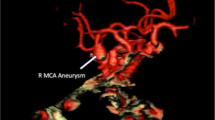Abstract
Cerebral delayed ischemia due to arterial vasospasm is a rare complication following epilepsy surgery. Here we report the third known case and first of diffuse vasospasm. A 48-year-old woman underwent a transcortical anterior left temporal lobectomy. Eleven days later, she had new-onset expressive aphasia with narrowing of the anterior, middle, and posterior cerebral arteries, and increased velocities via transcranial Doppler. She was treated with fluids, nimodipine, and permissive hypertension. At 6 months, her speech was near baseline. Cerebral vasospasm may represent a rare cause of morbidity after anterior temporal lobectomy; a literature review on the subject is presented.


Similar content being viewed by others
Abbreviations
- SAH:
-
Subarachnoid hemorrhage
- MRI:
-
Magnetic resonance imaging
- PET:
-
Positron emission tomography
- NSICU:
-
Neuroscience intensive care unit
- CT:
-
Computed tomography
- POD:
-
Post-operative day
- MCA:
-
Middle cerebral artery
- CTA:
-
Computed tomography angiography
- ICA:
-
Internal carotid artery
- ACA:
-
Anterior cerebral artery
- IV:
-
Intravenous
- CSF:
-
Cerebrospinal fluid
References
Aoki N, Origitano TC, al-Mefty O (1995) Vasospasm after resection of skull base tumors. Acta Neurochir 132(1–3):53–58 Retrieved from http://www.ncbi.nlm.nih.gov/pubmed/7754859
Chaichana K, Riley LH, Tamargo RJ (2007) Delayed cerebral vasospasm secondary to bacterial meningitis after lumbosacral spinal surgery: case report. Neurosurgery 60(1):E206–E207. https://doi.org/10.1227/01.NEU.0000249193.68904.B4
Chakravarty A, Anand S (2015) Cerebral vasospasm after selective amygdalohippocampectomy. Indian J Anaesth 59(6):380–382. https://doi.org/10.4103/0019-5049.158763
Claassen J, Bernardini GL, Kreiter K, Bates J, Du YE, Copeland D et al (2001) Effect of cisternal and ventricular blood on risk of delayed cerebral ischemia after subarachnoid hemorrhage: the fisher scale revisited. Stroke 32(9):2012–2020 Retrieved from http://www.ncbi.nlm.nih.gov/pubmed/11546890
Fassbender K, Ries S, Schminke U, Schneider S, Hennerici M (1996) Inflammatory cytokines in CSF in bacterial meningitis: association with altered blood flow velocities in basal cerebral arteries. J Neurol Neurosurg Psychiatry 61(1):57–61 Retrieved from http://www.ncbi.nlm.nih.gov/pubmed/8676162
Frontera JA, Claassen J, Schmidt JM, Wartenberg KE, Temes R, Connolly ES et al (2006) Prediction of symptomatic vasospasm after subarachnoid hemorrhage: the modified fisher scale. Neurosurgery 59(1):21–27. https://doi.org/10.1227/01.NEU.0000218821.34014.1B
Goodman RR (2013) Cerebral vasospasm after temporal lobe epilepsy surgery: clinically important? Epilepsy Currents 13(2):69–70. https://doi.org/10.5698/1535-7597-13.2.69
Hansen-Schwartz J (2004) Cerebral vasospasm: a consideration of the various cellular mechanisms involved in the pathophysiology. Neurocrit Care 1(2):235–246. https://doi.org/10.1385/NCC:1:2:235
Kassell NF, Sasaki T, Colohan AR, Nazar G (1985) Cerebral vasospasm following aneurysmal subarachnoid hemorrhage. Stroke 16(4):562–572 Retrieved from http://www.ncbi.nlm.nih.gov/pubmed/3895589
Lackner P, Koppelstaetter F, Ploner P, Sojer M, Dobesberger J, Walser G, Schmutzhard E, Schmidauer C, Bauer R, Unterberger I, Ortler M, Trinka E (2012) Cerebral vasospasm following temporal lobe epilepsy surgery. Neurology 78(16):1215–1220. https://doi.org/10.1212/WNL.0b013e318250d7d6
Maeda K, Kurita H, Nakamura T, Usui M, Tsutsumi K, Morimoto T, Kirino T (1997) Occurrence of severe vasospasm following intraventricular hemorrhage from an arteriovenous malformation. J Neurosurg 87(3):436–439. https://doi.org/10.3171/jns.1997.87.3.0436
Mandonnet E, Chassoux F, Naggara O, Roux FX, Devaux B (2009) Transient symptomatic vasospasm following antero-mesial temporal lobectomy for refractory epilepsy. Acta Neurochir 151(12):1723–1726. https://doi.org/10.1007/s00701-009-0314-5
Martin NA, Doberstein C, Alexander M, Khanna R, Benalcazar H, Alsina G et al (1995) Posttraumatic cerebral arterial spasm. J Neurotrauma 12(5):897–901. https://doi.org/10.1089/neu.1995.12.897
O’Brien TJ, Cascino GD (2012) Should patients be routinely assessed for cerebral vasospasm after temporal lobe epilepsy surgery? Neurology 78(16):1196–1197. https://doi.org/10.1212/WNL.0b013e318250d85b
Oertel M, Boscardin WJ, Obrist WD, Glenn TC, McArthur DL, Gravori T, Lee JH, Martin NA (2005) Posttraumatic vasospasm: the epidemiology, severity, and time course of an underestimated phenomenon: a prospective study performed in 299 patients. J Neurosurg 103(5):812–824. https://doi.org/10.3171/jns.2005.103.5.0812
Ross D, Rosegay H, Pons V (1988) Differentiation of aseptic and bacterial meningitis in postoperative neurosurgical patients. J Neurosurg 69(5):669–674. https://doi.org/10.3171/jns.1988.69.5.0669
Schaller C, Zentner J (1998) Vasospastic reactions in response to the transsylvian approach. Surg Neurol 49(2):170–175 Retrieved from http://www.ncbi.nlm.nih.gov/pubmed/9457267
Schaller C, Klemm E, Haun D, Schramm J, Meyer B (2002) The transsylvian approach is “minimally invasive”; but not “atraumatic”. Neurosurgery 51(4):971–976 Retrieved from http://www.ncbi.nlm.nih.gov/pubmed/12234405
Schaller C, Jung A, Clusmann H, Schramm J, Meyer B (2004) Rate of vasospasm following the transsylvian versus transcortical approach for selective amygdalohippocampectomy. Neurol Res 26(6):666–670. https://doi.org/10.1179/016164104225015921
Wang K-W, Chang W-N, Huang C-R, Tsai N-W, Tsui H-W, Wang H-C et al (2005) Post-neurosurgical nosocomial bacterial meningitis in adults: microbiology, clinical features, and outcomes. J Clin Neurosci 12(6):647–650. https://doi.org/10.1016/j.jocn.2004.09.017
Weir B, Grace M, Hansen J, Rothberg C (1978) Time course of vasospasm in man. J Neurosurg 48(2):173–178. https://doi.org/10.3171/jns.1978.48.2.0173
Zhu T, Yao Z, Yuan H, Lu B, Yang S (2004) Changes of interleukin-1 beta, tumor necrosis factor alpha and interleukin-6 in brain and plasma after brain injury in rats. Chin J Traumatol 7(1):32–35 Retrieved from http://www.ncbi.nlm.nih.gov/pubmed/14728816
Author information
Authors and Affiliations
Corresponding author
Ethics declarations
Conflict of interest
The authors declare that they have no conflict of interest.
Ethical approval
This article does not contain any studies with human or animal participants performed by any of the authors.
Patient consent
The patient consented for the use of their case in scholarly activities, such as education and research.
Additional information
This work has not been previously presented at any conference or published elsewhere.
There was no clinical trial registration number for this work.
This article is part of the Topical Collection on Functional Neurosurgery–Epilepsy
Rights and permissions
About this article
Cite this article
Dickerson, J.C., Hidalgo, J.A., Smalley, Z.S. et al. Diffuse vasospasm after transcortical temporal lobectomy for intractable epilepsy. Acta Neurochir 160, 1883–1887 (2018). https://doi.org/10.1007/s00701-018-3606-9
Received:
Accepted:
Published:
Issue Date:
DOI: https://doi.org/10.1007/s00701-018-3606-9




